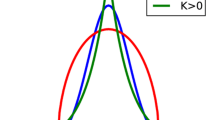Abstract
The aims of this study were to implement voxel-based optimization diffusion kurtosis imaging (DKI) and evaluate the accuracy of the method for the analysis of diffusion imaging data in comparison with conventional DKI. Conventional DKI and voxel-based optimization DKI were tested on a phantom and a human in a 1.5 T whole-body scanner. The differences in the diffusion coefficient (D) and diffusion kurtosis (K) values were analyzed using the Mann–Whitney U test, and the Holm correction was applied to the statistical analyses. In the phantom study, the D value resulting from voxel-based optimization DKI was significantly lower than those from conventional DKI in water and agarose solutions at concentrations of 50 and 100 g/L (all p < 0.01). Moreover, the K value was significantly lower in the water and agarose solutions at concentrations of 50, 100, and 200 g/L (all p < 0.01). In the human study, the D value resulting from voxel-based optimization DKI was significantly lower than that of conventional DKI in both white matter (WM), and gray matter (GM) (all p < 0.01). Moreover, the K value was significantly lower in cerebrospinal fluid, WM, and GM (all p < 0.01). To correctly measure the DKI, the optimized b values for each voxel must be used. Voxel-based optimization DKI is a method that optimizes the b values for each voxel. It appears that voxel-based optimization DKI improves the accuracy of the K value for biological tissues.







Similar content being viewed by others

References
Castillo M, Smith JK, Kwock L, Wilber K. Apparent diffusion coefficients in the evaluation of high-grade cerebral gliomas. AJNR Am J Neuroradiol. 2001;22(1):60–4.
Kono K, Inoue Y, Nakayama K, Shakudo M, Morino M, Ohata K, Wakasa K, Yamada R. The role of diffusion-weighted imaging in patients with brain tumors. AJNR Am J Neuroradiol. 2001;22(6):1081–8.
Charles-Edwards EM, deSouza NM. Diffusion-weighted magnetic resonance imaging and its application to cancer. Cancer Imaging. 2006;6:135–43.
Attariwala R, Picker W. Whole body MRI: improved lesion detection and characterization with diffusion weighted techniques. J Magn Reson Imaging. 2013;38(2):253–68.
Mulkern RV, Zengingonul HP, Robertson RL, Bogner P, Zou KH, Gudbjartsson H, Guttmann CR, Holtzman D, Kyriakos W, Jolesz FA, Maier SE. Multi-component apparent diffusion coefficients in human brain: relationship to spin-lattice relaxation. Magn Reson Med. 2000;44(2):292–300.
Jensen JH, Helpern JA, Ramani A, Lu H, Kaczynski K. Diffusional kurtosis imaging: the quantification of non-gaussian water diffusion by means of magnetic resonance imaging. Magn Reson Med. 2005;53(6):1432–40.
Jensen JH, Helpern JA. MRI quantification of non-Gaussian water diffusion by kurtosis analysis. NMR Biomed. 2010;23:698–710.
Fukunaga I, Hori M, Masutani Y, Hamasaki N, Sato S, Suzuki Y, Kumagai F, Kosuge M, Hoshito H, Kamagata K, Shimoji K, Nakanishi A, Aoki S, Senoo A. Effects of diffusional kurtosis imaging parameters on diffusion quantification. Radiol Phys Technol. 2013;6(2):343–8.
Wang C, Ren D, Guo Y, Xu Y, Feng Y, Zhang X, Mei Y, Chen M, Xiao X. Distribution of intravoxel incoherent motion MRI-related parameters in the brain: evidence of interhemispheric asymmetry. Clin Radiol. 2017;72(1):94.e1–.e6.
Lu H, Jensen JH, Ramani A, Helpern JA. Three-dimensional characterization of non-gaussian water diffusion in humans using diffusion kurtosis imaging. NMR Biomed. 2006;19(2):236–47.
Ogura A, Koyama D, Hayashi N, Hatano I, Osakabe K, Yamaguchi N. Optimal b values for generation of computed high-b-value DW images. AJR. 2016;206:713–8.
Ogura A, Hatano I, Osakabe K, Yamaguchi N, Koyama D, Watanabe H. Importance of fractional b value for calculating apparent diffusion coefficient in DWI. AJR. 2016;207(6):1239–43.
Yang AW, Jensen JH, Hu CC, Tabesh A, Falangola MF, Helpern JA. Effect of cerebral spinal fluid suppression for diffusional kurtosis imaging. J Magn Reson Imaging. 2013;37(2):365–71.
Le Bihan D, Breton E, Lallemand D, Aubin ML, Vignaud J, Laval-Jeantet M. Separation of diffusion and perfusion in intravoxel incoherent motion MR imaging. Radiology. 1988;168(2):497–505.
Acknowledgements
The author would like to thank Takeshi Nitanai and Tetsuya Matsumoto for their help in this study.
Author information
Authors and Affiliations
Corresponding author
Ethics declarations
Conflict of interest
The authors declare that they have no conflicts of interest.
Statement of human and animal rights
All procedures performed in studies involving human participants were in accordance with the ethical standards of the institutional review board and with the 1964 Helsinki declaration and its later amendments or comparable ethical standards. This article does not contain any studies performed with animals.
Informed consent
Informed consent was obtained from all participants included in the study.
Additional information
Publisher's Note
Springer Nature remains neutral with regard to jurisdictional claims in published maps and institutional affiliations.
About this article
Cite this article
Maehara, M. Development of voxel-based optimization diffusion kurtosis imaging (DKI) and comparison with conventional DKI. Radiol Phys Technol 12, 290–298 (2019). https://doi.org/10.1007/s12194-019-00523-9
Received:
Revised:
Accepted:
Published:
Issue Date:
DOI: https://doi.org/10.1007/s12194-019-00523-9



